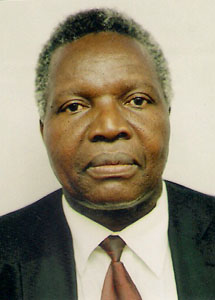Local Publications
The following publications used ISAAC data from the Eldoret centre:
- Esamai F, Anabwani GM. Prevalence of asthma, allergic rhinitis and dermatitis in primary school children in Uasin Gishu district, Kenya. E Afr Med J 1996; 73(7): 474-8.
- Esamai F, Ayaya S, Nyandiko W. Prevalence of asthma, allergic rhinitis and dermatitis in primary school children in Uasin Gishu district, Kenya. E Afr Med J 2002; 79(10): 514-8.
Eldoret Centre
| Phase OneView Centre Details | Phase Two | Phase Three | |||
| Centre: | Eldoret, Kenya ( Africa ) | ||||
| Principal Investigator: | Dr Fabian O Esamai | ||||
| Age Groups: | 13-14 | Timeframe: | February 2001 to April 2001 | ||
| Sampling Frame: | 13-14yr: All schools in Aiwabkoi, Kapsaret and Kesses Divisions in Uasin Gishu District. The same sampling frame as Phase One. | ||||
Personnel
Personnel
Dr Fabian O Esamai

Department of Child Health and Paediatrics
Moi University
PO Box 4606
Kenya
Roles:
- Phase One Principal Investigator for Eldoret
- Phase Three Principal Investigator for Eldoret
Eldoret Kenya ISAAC centre
The Eldoret centre is one of the two in Kenya and participated in Phase One of ISAAC as the rural centre while Nairobi was the urban centre. This enabled a rural – urban comparison on the prevalence of asthma, allergic rhinitis and allergic conjunctivitis. The researchers were based at the Moi University School of Medicine in the Department of Child Health and Paediatrics. Moi University School of Medicine was the second medical school in Kenya after the Nairobi Medical School. It applies the innovative problem based approach to medical education with a strong community based component.
The investigators for Phase One were Gabriel Anabwani, who was also the Regional Coordinator and Fabian Esamai, the Principal Investigator for the Eldoret centre in Kenya. Prof. Gabriel Anabwani has since 1997 left the Department for Botswana. Prof. Gabriel Anabwani was the Professor of Paediatrics in the department until his departure in 1997. Professor Fabian Esamai who was a Senior lecturer at the time of Phase One is the Professor of Paediatrics in the department since 2005. He has been in the department since the start of the Moi University Medical school in 1990. The field work for Phase One was conducted by Joel Kirinyet, the Chief technician in the department, as the coordinator of the field team.
ISAAC Phase One was the first rural study in Kenya to study the prevalence of asthma and allergies. Most earlier studies were urban and more so for adults.
The participants for Phase Three included Prof. Fabian Esamai, Dr. Samuel Ayaya and Dr. Winstone Nyandiko. This phase was conducted in 2001. ISAAC Phase Three was led by the Public Health team of the Uasin Gishu district Ministry of Health.
The prevalence of asthma remained unknown in Eastern Africa for decades as there were limited studies especially community based studies until about a decade ago when the International Study of Asthma and allergies in Children (ISAAC) was conducted worldwide. In East Africa two Kenyan centres (Nairobi and Eldoret) and Ethiopia were included in the phase I between 1994 and 1996. The Nairobi centre represented studies on urban children while the Eldoret centre represented the rural based children. Eldoret is situated in the Rify valley highlands of Kenya 340 kilometres west of Nairobi. The same study procedure was repeated 6 years later in the same locations and schools in Nairobi and Eldoret in a phase III to assess trends between 2001 and 2003. The ISAAC study in these centres included school children aged 13-14 years of age.
With the establishment of industries in urban and rural East African countries, the risk of allergic induced asthma and asthma related to industrial pollution is on the increase and could be responsible for the rise in both urban and rural asthma prevalence. The adoption of western lifestyles and associated improvement in living standards could be a contributor to the increasing prevalence of athma in children. Other risk factors include indoor pollution from smoke from cooking in poorly ventilated houses, indoor cigarette smoking by parents or guardians and indoor allergens like dust mites in the home. Allergies to pollens could be another risk factor especially with increase flower farming for export in the horticulture industry in which Kenya and other east African countries have extensively expanded over the last decade. Other risk factors includes keeping of pets and domestic animals like dogs, cats, chicken etc to which children develop allergy to their droppings, fur and other parts. Some children react to animal protein and with improved purchasing power, more children get exposed to these products. The use of processed and canned foods could have contributed to the development of allergies that predispose to asthma symptoms. The genetic risk factor has been known for years in developed and developing countries and still contributes to about 40% of all asthmatics among children. Asthma has been observed to run in families and therefore this should always be established from family interviews.
Avoidance of asthma triggers reduces the development of asthma symptoms and attacks and reduces the need for medications. Common asthma triggers include domestic dust mites, tobacco smoke, animal fur, cockroach allergens, outdoor pollens and molds, indoor mold and physical activity for exercise induced asthma.
Bed linens and blankets should be washed weekly in hot water and dried, pillows should be encased in pillow cases and avoid carpets or they should not be in sleeping rooms.
Children should be kept away from tobacco smoke and parents or guardians should not smoke.
Animals should be kept away from sleeping areas of the home.
Spray homes frequently to kill cockroaches using pesticides but in the absence of children.
Children should be kept away from farms during the period of pollination of crops and plants. Doors and windows should be closed during these periods.
Clean damp areas frequently and children with exercise induced asthma should avoid physical activity.
